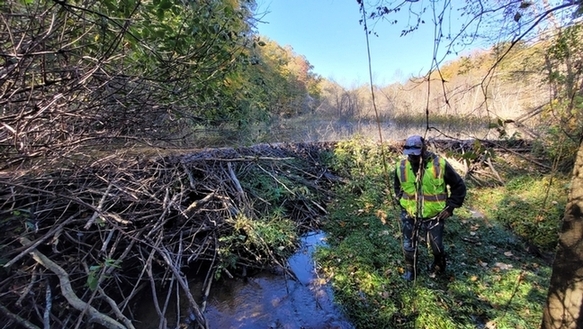A North American Beaver eating on the shore.
A North American Beaver performing maintenance on a beaver dam.
Fact File
Scientific Name: Castor canadensis
Classification: Mammal, Order Rodentia, Family Castoridae
Size: The North American Beaver reaches a total length of 3 to 4 feet in length with weights ranging between 30 to 75 pounds
Life Span: The North American Beaver lives for 10 to 12 years in Virginia
Identifying Characteristics
- Heavily built with short legs, a horizontally flattened and scaly tail, and webbed hind feet
- Fur is glossy dark brown above, with lighter under parts
- The tail becomes lighter with age
- The eyes are small
- The front feet have strong claws adapted for digging and grasping tree limbs
Distribution
The North American Beaver is native throughout all of Virginia, but higher densities can be found in lower gradient areas of the Piedmont and Coastal Plain.

Diet
The North American Beaver consumes herbaceous vegetation in the spring and summer when it is readily available. During colder seasons, their forage is dominated by twigs and branches which they often cache near their lodge. During the winter, the beaver can also draw upon fat reserves from the body, including the tail.
Habitat
The North American Beaver can most often be found along streams, although they can be found near lakes and swamps when sufficient food is available.
Behavior and Reproduction
The North American Beaver often constructs dams with the intent of slowing the transport of water which results in an ideal habitat for their lodge – providing sustainable food, water, and cover. Additionally, beaver dams result in a number of invaluable ecosystem services that benefit a multitude of other aquatic, avian, and terrestrial wildlife species. Such services also benefit humans through reducing the severity of droughts and floods, attracting desirable wildlife species, and even contributing to groundwater recharge.
The North American Beaver is primarily nocturnal and lives in colonies that are comprised of 4 to 8 related individuals. The colony has a home range size of about 8 acres.
The North American Beaver is monogamous, and produces up to one litter per year. The litter can range from 1 to 6 individuals, but typically consists of 3 to 5. In Virginia, the North American Beaver are born between April and June. The young beaver grow slowly and will stay with their family group for around 2 years, at which time they will disperse to establish a colony of their own.
The tail of the North American Beaver serves as both a rudder while swimming and as a warning signal – when alarmed, the beaver can slap the water with its tail, creating a loud splash that can warn other beavers to potential danger.
Managing Human-Wildlife Conflicts with Beavers
Due to an innate need and competition for the same areas, conflict between beavers and humans in some areas is inevitable. For additional information on how to best approach these situations please visit our Nuisance Beaver Page.

DWR Biologists inspect a beaver dam near a box culvert in Carolina County.
Last updated: March 18, 2025
The Virginia Department of Wildlife Resources Species Profile Database serves as a repository of information for Virginia’s fish and wildlife species. The database is managed and curated by the Wildlife Information and Environmental Services (WIES) program. Species profile data, distribution information, and photography is generated by the Virginia Department of Wildlife Resources, State and Federal agencies, Collection Permittees, and other trusted partners. This product is not suitable for legal, engineering, or surveying use. The Virginia Department of Wildlife Resources does not accept responsibility for any missing data, inaccuracies, or other errors which may exist. In accordance with the terms of service for this product, you agree to this disclaimer.

